Bushes and trees with burgundy purple foliage. plants with red leaves
Despite the fact that in summer time the garden pleases with a riot of colors, many owners want to add some more bright and original touches to the landscape. Ornamental shrubs for summer cottages with red leaves successfully cope with this task.
These plants are able to transform your summer cottage beyond recognition. Such shrubs set the right accents, allowing the garden to look bright and original at any time of the year. Today we will introduce you to some of them.
Barberries with purple foliage
It is not in vain that we begin our review with these red-leaved shrubs. They are very fond of being used by landscape designers, and gardeners have appreciated the beauty of these plants. The red-leaved barberry attracts with purple foliage from early spring. It never ceases to delight decorativeness until the first frost.
These unpretentious shrubs, which harmoniously fit into any landscape, have long been welcome guests on many garden plots middle lane. Due to its unsurpassed decorative characteristics, the barberry can be used everywhere - in combination with conifers, as a hedge, in single plantings. Below we will present you the most popular varieties.

Barberry Ottawa Superba
Shrub, whose height is about three meters, of incredible beauty. Differs in exquisite flowering and is a worthy decoration of any suburban area. This variety has a fairly large, sprawling crown with long annual growth. Numerous shoots are armed with large spines.
The burgundy leaves have a faint metallic tinge in the summer. In autumn, the leaves turn bright red. Flowering begins in May. Shrubs are covered with yellow flowers with a red border, which are collected in racemose inflorescences. They have a strong and very pleasant smell.
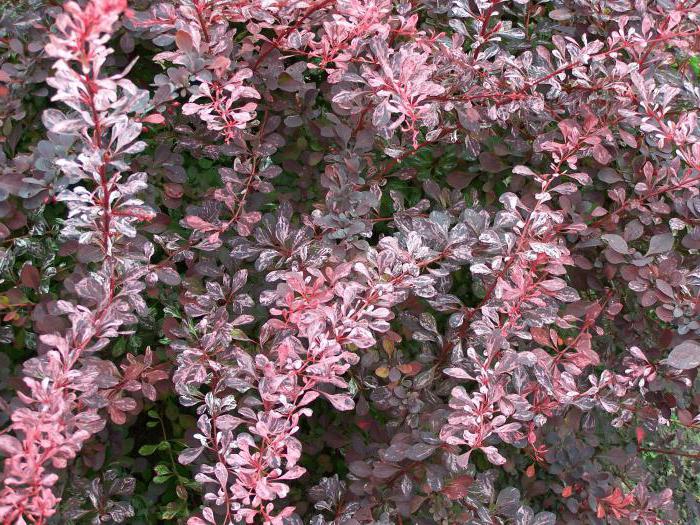
The fruits hang down spectacularly on curved branches, somewhat elongated, edible, with a characteristic sour taste. They are also painted bright red. The plant is photophilous, but tolerates partial shade. In sunny areas, the color of the leaves is more saturated.
The bush tolerates extreme heat and drought well, is undemanding to the composition of the soil, but develops better on alkaline soils. Does not tolerate moisture stagnation. It is used as a tapeworm on the lawn, to create arrays, in ordinary plantings, in borders, growing hedges.
Barberry Thunberg
A bright representative of a large family. Such barberry bushes are beautiful in winter - against the background of snow, its reddish stems covered with small thorns look very impressive. In the spring, when the plant awakens, its leaves are painted in an unusually beautiful copper-red color and, contrasting with them, yellow tassels of flowers bloom. In summer, the leaves of the Thunberg barberry are painted in rich purple hues, and in the fall, the shrubs simply fascinate with their beauty. The bright colors of the flame cover the entire bush from below and to the tips of graceful and elongated branches.
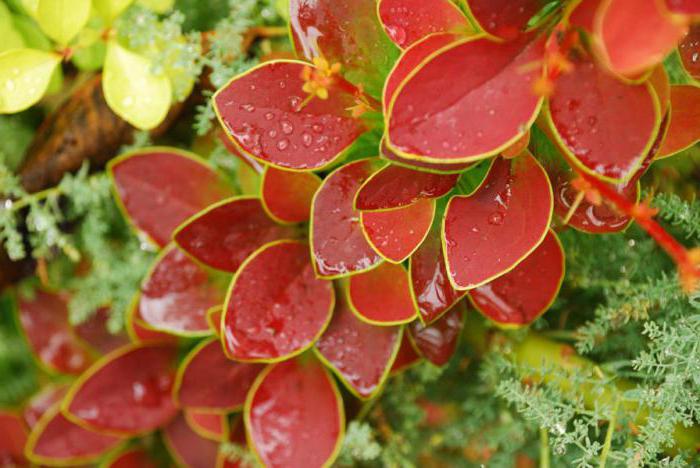
Barberry Thunberg has many varieties. We will talk about the most common red ornamental shrubs.
Atropurpurea Nana
This is perhaps the most popular Thunberg barberry. A miniature shrub with red leaves, the height of which does not exceed sixty centimeters. Its crown is compact, flat-round. It has a rather slow growth. It blooms with beautiful flowers: they are yellow inside, and bright red outside, forming racemose inflorescences. Bright red fruits remain on the branches throughout the winter. 
The leaves are small, at first they are painted in dark red (almost black) color, then they become rich red. In autumn they turn bright red. The plant is undemanding to soils, it has proved itself well in urban conditions.
Admiration
Miniature shrub with red leaves of extraordinary beauty. An adult plant does not exceed 50 cm in height, and this is with the same crown diameter, which has a rounded shape. She is very dense. The leaves are small red with an original thin yellow border.
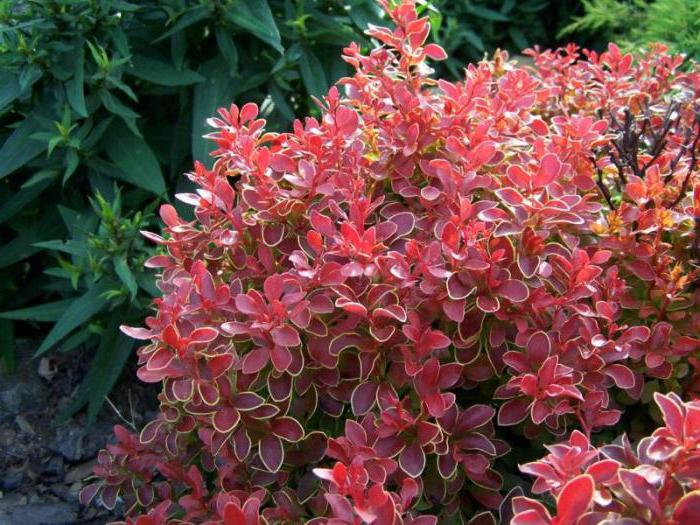
The flowers are yellow, with a slight reddish tinge, may be single or in bunches. Flowering occurs in May. The fruits are oblong, raspberry-red, fully ripe in October.
It is undemanding to soils, it develops well in urban conditions. Grows best in well-lit areas. They are used to create low curbs, in rocky hills, in compositions, for single and group planting.
Bagatelle
Dwarf shrubs with red leaves are unusually good. An example of this is Bagatelle. Its height is about forty centimeters, while the diameter of the crown can reach a meter. The annual increase in width and height is about three centimeters.
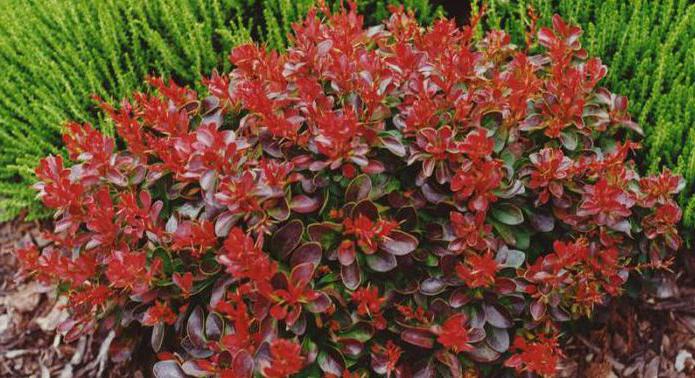
These unpretentious shrubs have a fairly dense crown. The leaves are ovoid, not more than one and a half centimeters long, dark red. In autumn they turn carmine red.
It blooms in May with yellow-red small flowers collected in beautiful brushes. The fruits are bright red, shiny, up to a centimeter in size. They usually ripen in early October.
It is undemanding to soils, tolerates short-term drought well. It is used in rockeries, discounts, group plantings, rock gardens, borders.
southern skumpia
These shrubs with red leaves prefer regions with a hot climate - the Caucasus, the Mediterranean, Crimea. With the onset of autumn, their foliage turns scarlet, dark pink or orange. At first, the veins become scarlet, and then the bright color spreads throughout the leaf blade. Skumpia has beautiful large leaves, shaggy pink inflorescences, which are successfully used in decorative art.
In countries with a warm climate, this plant is very popular for decoration. personal plots and gardens, parks, squares. Looks great in a single landing and is used to create hedges. It is recommended to plant in well-lit areas, but they must be protected from drafts and gusts of wind.
This plant does not require frequent watering: once every few weeks is enough. Fertilizers are applied to the soil in autumn or spring, before the appearance of inflorescences. Phosphate or mineral fertilizers are used as top dressing. Interestingly, if you rub a leaf of skumpia in your hands, you can smell the smell of carrots.
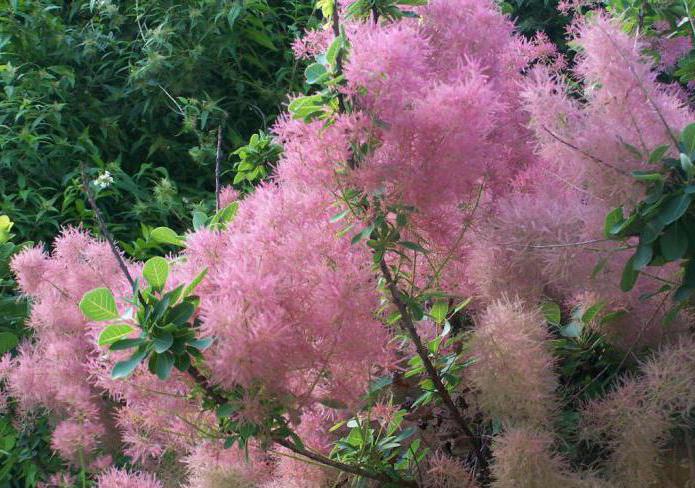
Skumpia is especially beautiful during the flowering period, which usually occurs in the second half of summer. Paniculate branching inflorescences resemble clouds from a distance. When the flowers fall, pink stalks remain. Thanks to them, the plant received a second name - a wig tree, since these threads are very reminiscent of thick hair.
The plant is unpretentious to soils, feels comfortable in the garden, can grow even on stony soils. But it also has a significant drawback: it is not very winter-hardy.
Red Japanese Maple
If you like a riot of red shades on your site, then pay attention to the red Japanese maple. This shrub has a large crown. At first, its foliage is bright green, but in late summer it turns reddish-orange, and then acquires a bright red, carmine hue.
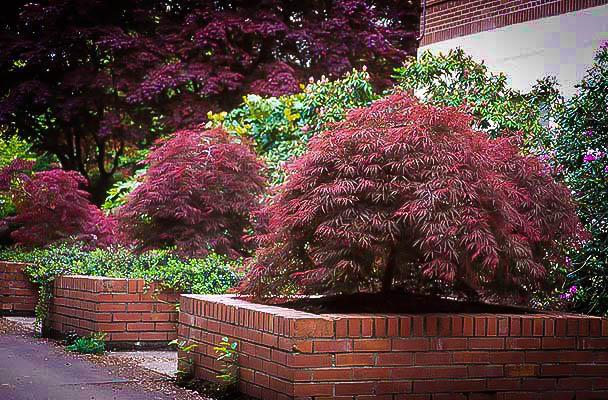
The Japanese maple has many varieties, each of which is distinguished by the color of the foliage: the Aconitifolium variety has orange-red leaves, the Vitifolium variety has carmine-red leaves. But the most popular - Atropurpureum - with dark red foliage. These large shrubs look great anywhere, prefer partial shade, are in perfect harmony with coniferous plants, ferns, hostas.
shrub euonymus
This is the perfect backyard decoration. In our country, the euonymus shrub has several more names: wolfberry, wolf earrings, bruslina, night blindness. The plant is actively used in landscape design. This is due to the high decorative qualities and ease of care for him.
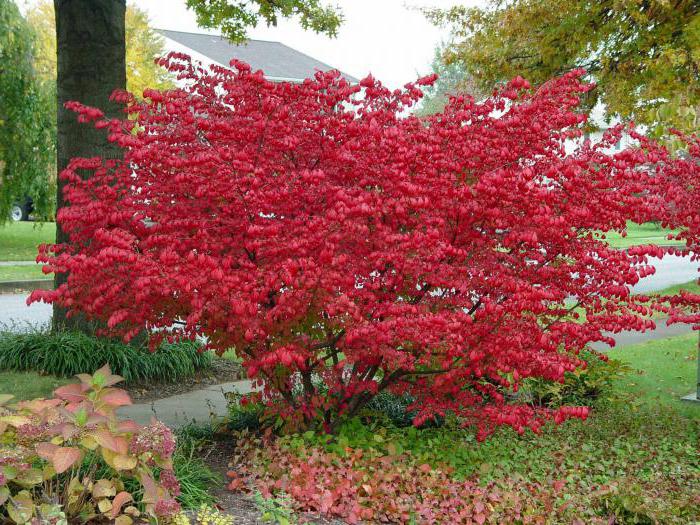
Fortune's Euonymus
Compact height not exceeding sixty centimeters. He is from China. It has many varieties, which are distinguished by the variegated color of the foliage. This plant can be shaped into a bush or liana using ropes. With its aerial roots, the euonymus will cling to any support. Depending on the variety, the leaves have a different color edging.
Bubbleweed Diable d'Or Mindia
Dense, fairly tall shrub (about two meters) with straight shoots. The leaves are dark purple in color, young bushes have orange shoots. The flowers are white, semi-double and very fragrant.
The plant needs nutritious, moist, slightly acidic soils and a well-lit area for planting. It can be used both in group plantings and in single plantings to create hedges, contrasting groups.
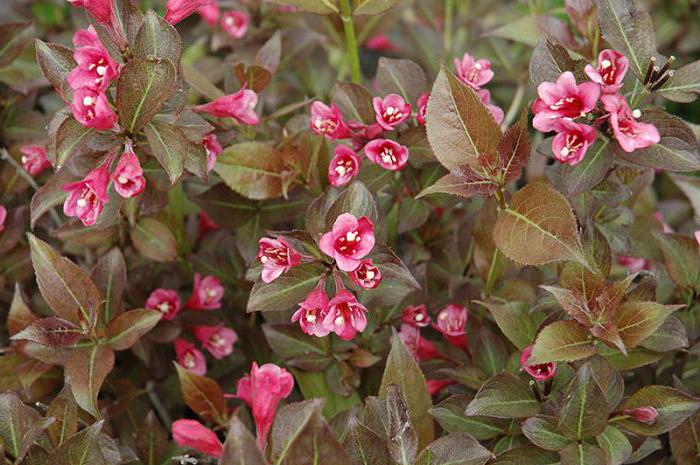
Vesicle Little Devil Donna May
An undersized miniature variety, the height of which does not exceed eighty centimeters. The leaves are small and dark purple in color. They retain their decorative effect throughout the season. Flowering begins in early June, when small flowers appear on the plant white color collected in a corymbose inflorescence.
The shrub is undemanding to humidity. Tolerates drought well. In order for this variety to please with a bright saturated color of foliage, it must be planted in sunny areas. This plant needs annual formative pruning, which boils down to cutting damaged and weak shoots in early spring. It is used as an accent plant in group plantings and for creating hedges.
As you can see, not only flowers can decorate the garden. Various shrubs with red leaves can give it a special attraction. It doesn't have to be flowering. Gorgeous foliage in different shades of red will bring originality and sophistication to the landscape.
There are many ways to make your backyard attractive. You can use garden decor, but many flower growers and summer residents prefer as decorative ornament Natural flowers. Some of the most beloved are shrubs with red leaves, as they favorably set off greenery and stand out from the general background. Therefore, they are often used in the landscape.
Barberry - common red shrubs for garden decoration. They have burgundy, scarlet or purple foliage with a bright green edging. The barberry looks especially impressive in a single composition, but it can also complement the overall landscape design. The popularity of this shrub with red foliage is due not only to its beauty, but also to the fact that it is not demanding on growing conditions. Certain varieties of barberries, such as Thunberg, have a burgundy color throughout the year.
One of the most grown red-leaved shrubs is the Thunberg barberry.
Some ornamental shrubs turn bright purple only when autumn arrives. Among such varieties is the Ottawa Auricoma. Such a plant has a bright purple color of foliage, in autumn they become bright orange in color. Planting red shrubs in the backyard different types, you can extend the attractiveness of the estate until the beginning of the first frosts.
Barberry with green-red leaves looks good in a single composition. Also, often with the help of such shrubs, a hedge is created. For a hedge, it is necessary to observe certain distances during planting so that the plants do not shade each other, in order to prevent stagnation of water during irrigation and ensure the full growth of neighboring bushes.
You can give the desired shape to the shrub - cut it. Thanks to shaping and cutting, the plant will look neater, especially if a hedge is created. The barberry hedge looks beautiful against the backdrop of lawn grass and gravel paths. It is easy to take care of such plantings - it is enough to irrigate the soil abundantly once a week, make sure that the leaves are not covered. spider mite, aphids. If diseases or pests are detected, it is recommended to treat the bushes with fungicidal or acaricidal preparations.
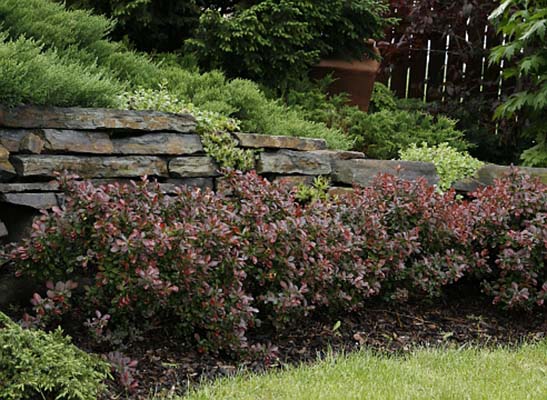
Barberry Thunberg
Bushes with green-red leaves will look great next to coniferous plants - miniature thujas, pines, as well as bushes or ground covers with yellow leaves. To create picturesque landscape images, you can plant dwarf species barberry. Such compositions are created in rocky gardens, for mixborders or borders. When planting several different types of bushes, it is necessary to maintain harmony so that they are combined in color and height so that they do not obscure each other.
When the berries of the plant begin to ripen, the deciduous mass becomes purple, it looks especially beautiful against the background of a green lawn. You can buy barberry at specialized points of sale, in nurseries and garden nurseries. Thanks to plants, you can hide defects in the garden, and the deciduous mass does not require special care - you can periodically irrigate it from a spray bottle. If you mulch the soil around the barberry, the number of growing weeds will decrease and the root system will grow faster in a new place.
Maple
Another beautiful ornamental shrub with red yellow leaves is a red maple. It is often used to decorate the backyard. Maple is native to Southeast Asia and Canada. In Japan, for many centuries, breeders have tried to develop a maple with red leaves. Today, the plant can be purchased at specialized points of sale without difficulty. In addition to scarlet leaves, the semi-shrub attracts with an unusual crown shape, which can be formed in the form of a circle, column, egg.
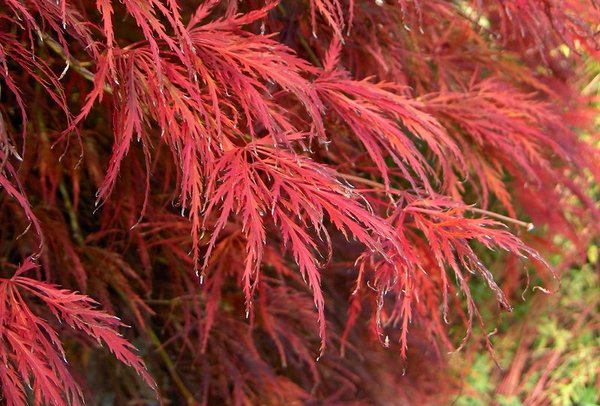
Japanese maple
The subtle pattern on the leaves makes them openwork appearance. A palm-shaped Japanese maple stands out against the general background of the garden. This small tree with openwork foliage will decorate a Japanese-style garden. Large boulders can be placed around it. Many gardeners prefer to plant a miniature shrub in barrels or buckets, if desired, they are rearranged to another place.
The most prominent representatives of this species include:
- Palm maple;
- Maple Shirasawa;
- Japanese red.
Looks great as a single plant, and when planted in groups. But such a shrub is somewhat demanding on growing conditions. It does not tolerate direct sunlight, so experienced gardeners recommend planting in a semi-shaded place, or shade with tall trees planting them in parallel. In an open area, you should not grow it in an open place, as the leaves will get burned, begin to dry out and curl.
Watering is carried out once a week, thoroughly filling the soil substrate with water. Fertilizers are applied in autumn or spring, using mineral-phosphate or organic compounds. It is recommended to mulch the soil around the plant with sawdust or sod, this will retain moisture and reduce the number of weeds around the bush.
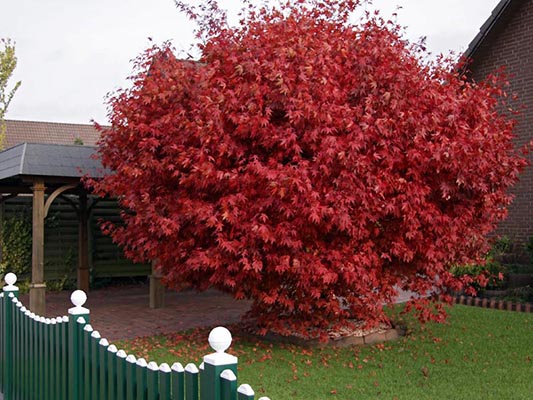
Maple with red leaves
You can use maple to decorate the patio, it complements coniferous plantings well. Under the spreading crown, an excellent partial shade is created for plants, so near the maple you can plant those flowers and ground covers that love partial shade and shade. A miniature tree looks especially advantageous during the period when bright scarlet buds bloom. You can plant a small group of them near the house, this will create a slight partial shade in the summer heat.
southern skumpia
Such a shrub prefers to grow in countries with hot climatic conditions - the Crimea, the Caucasus, the Mediterranean. Upon the arrival of the autumn period, the deciduous mass is painted in scarlet, orange or dark pink. At first, the veins turn scarlet, after which the bright color spreads over all the leaves. Skumpia has beautiful large leaves, pink shaggy inflorescences. They can be used in applied decorative arts.
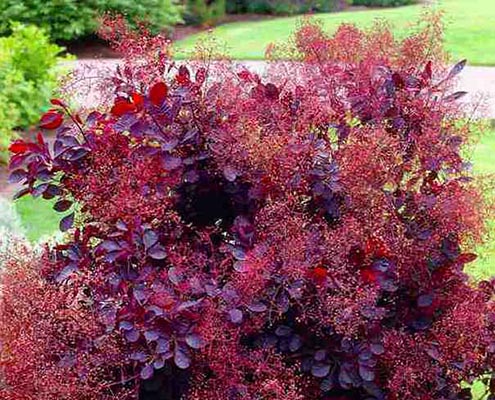
Red-leaved mackerel
In countries with warm climatic conditions, the plant is very popular for decorating the garden and garden plot, alleys, parks and squares. It looks great both as a single shrub and when creating landscape compositions, it is used to create hedges. It is recommended to plant in areas well lit by the sun, but at the same time they must be protected from direct gusts of wind and drafts. Watering can be done once every few weeks, plentifully irrigating the soil. Fertilizers are applied in the fall, during the harvest period or in the spring, before the appearance of inflorescences. Mineral or phosphate fertilizers are used as top dressing.
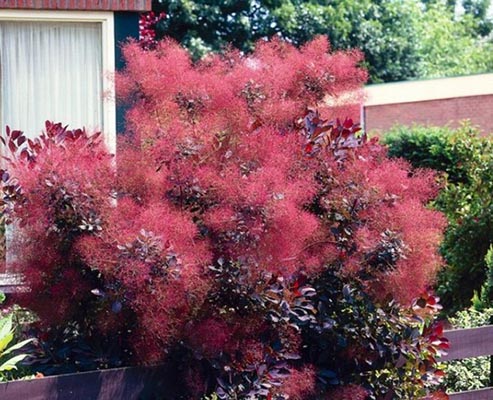
At kompia tannery Royal Pearl, not only the leaves are red, but also the flowers
With its help, you can skillfully hide unsuccessful buildings on a personal plot, forming hedge. But when choosing this plant, you need to remember that it tends to grow rapidly, so this must be taken into account when planting in groups. Skumpiya needs space. After a short period of time, a small sprout will become a luxurious bush that will become a real decoration of the garden, regardless of the season, especially during the flowering period.
decorative apple tree
This ornamental shrub with red leaves resembles sakura in appearance. During the formation of inflorescences, beautiful small pink flowers appear, after a while they turn into small red apples. People call them "paradise apples". This shrub does not need additional shaping, it usually forms a rounded crown on its own.
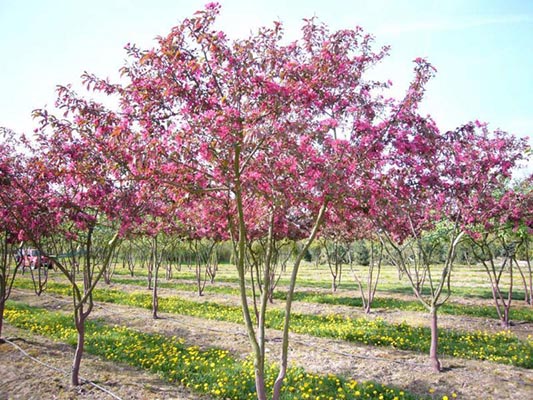
Ornamental apple tree Malus purpurea Royalty
A miniature tree in a single planting looks very advantageous. You can plant several apple trees along the fence, leaving them free space. The ornamental apple tree is distinguished by its unpretentiousness to growing conditions; it grows equally well in sunny areas, in shade and partial shade. An excellent quality of a decorative apple tree is its unpretentiousness to adverse climatic conditions. It is able to withstand even severe frosts, so it can be safely grown in countries with a cold climate.
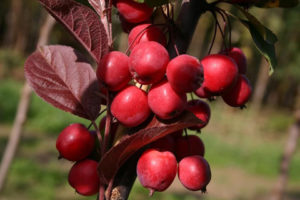
Nezdwiecki's apple tree
Red leaves in combination with red fruits look very harmonious. In addition, small apples have an unusual tart-sweet taste. You can water the shrub once every few weeks, abundantly flooding the soil. Fertilizers are applied in the autumn-spring period, before the appearance of the first inflorescences. Organic or mineral compounds are used as top dressing. In the shade of a shrub, ground cover plants are often planted that like to grow in the shade. You can also mulch the soil, so moisture will be retained and there will be no such rapid growth of weeds.
red-leaved plum
Plum with red leaves or cherry plum is an unpretentious semi-handicraft plant. It is also successfully used in landscape design. Beautiful dark red leaves and fruits are a real decoration of an outwardly unremarkable shrub. The crown is best formed by hand, so it will be a beautiful spherical shape. When planting as a hedge, you need to remember that the red-leaved plum needs space, as it will grow.

Red-leaved plum - cherry plum
Knowing the names and descriptions of red-leaved ornamental shrubs, you can decorate your garden and plot with both single plants and a real hedge or various landscape compositions. An indisputable positive aspect of such plants is their unpretentiousness to growing conditions and ease of care.
Viburnum viburnum has long been successfully used in landscape design. European breeders are growing new varieties of this shrub, which are distinguished by their unpretentiousness and amazing decorative effect. Among all the variety, varieties with foliage painted in different shades of red are distinguished by a festive outfit. Some of them received the well-deserved prize of the English Royal Horticultural Society, which is awarded to plants with especially pronounced decorative properties and unpretentiousness in care and reproduction.
Curious facts
Red-leaved varieties of vesicle prefer sunny open places. They also grow and develop well in the shade, but the bright foliage loses its individuality. From the lack of sunlight, it turns green and acquires an ordinary appearance.
Experts recommend propagating the vesicle with red foliage in one of the following ways: dividing the bush, cuttings, layering. Seeds also give good germination. But it is unlikely that seedlings grown in this way will acquire all varietal features. With a high degree of probability, their leaves will be green, not red.
Varieties of the vesicle differ not only in the color of the leaves. Varieties with red foliage are covered with a scattering of pink inflorescences during flowering, which adds decorativeness to shrubs.
Varieties with red leaves
The red-leaved shrubs of the vesicle are diverse in the shape of the bush and the shades of the foliage. The most popular varieties are:
Diabolo (Diabolo)
Mighty vesicle shrubs, if allowed to grow by chance, can reach a height of 3.5 meters and a width of 2 meters. Despite the fact that the branches of the plant are thin, not exceeding 1 centimeter in diameter, they are distinguished by a high density of planting foliage. Many maroon leaves are elliptical in shape. Looking at them, it seems that they are directed with their pointed tips exclusively towards the sun. Elegant foliage in autumn changes its color to yellow, no less festive.
Summer Wine (Summer Wine)
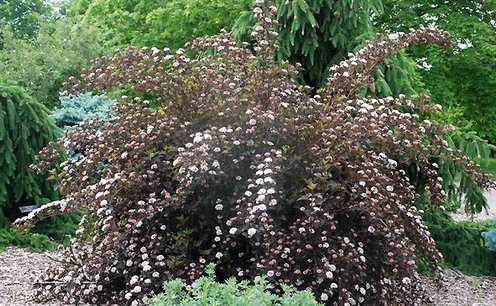 Vesicle grade summer wine
Vesicle grade summer wine A shrub with spreading branches is covered with bright foliage, reminiscent of red fortified wine in its color. The shape of the bush and the color of the leaves create an extraordinary effect. From the outside, they resemble a picture of wine splashes or fireworks. The branches of the plant are quite strong, reaching 1.5 - 2 centimeters in diameter. The bark is exfoliating, brown. This variety of vesicle blooms in spring, densely covered with white-pink inflorescences. The variety tolerates severe frosts well, so in Russia it can be grown in almost all regions.
Red Baron (Red Baron)
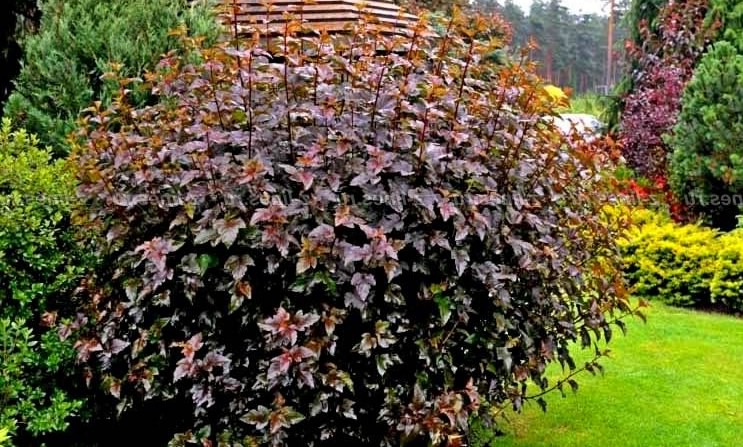 Vesicle red baron
Vesicle red baron It has a beautiful hemispherical crown shape. The height and width of an adult plant is almost the same: 2 meters in height and the same in width. During flowering, the bushes are covered with white-pink inflorescences. Dark red leaves, corrugated along the veins, have an elongated shape. In autumn they change their color to bronze.
Schuch (Shuh)
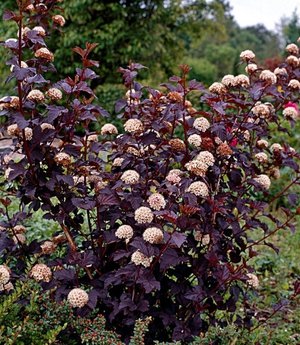
Shrubs of this variety of vesicles reach 2 meters in height. Branches with red-brown bark are covered with dark red foliage and directed upwards. In autumn, the color of the leaves remains unchanged.
Lady in Red (Lady in Red)
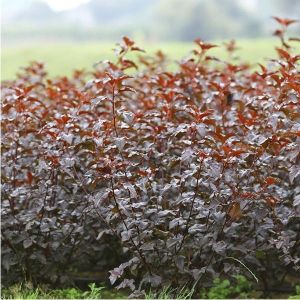 Vesicle Lady in red (Lady in Red)
Vesicle Lady in red (Lady in Red) The name "Lady in Red" speaks for itself. the vesicle was grown by English breeders. Beautifully shaped bushes do not exceed one and a half meters in height. The elegant foliage of bright red color becomes darker by autumn.
This is certainly an incomplete list of red-leaved vesicle varieties. But they are among the most popular among European specialists in landscape design. Their beauty, unpretentiousness, ease of reproduction were also appreciated by our gardeners.
growing conditions
Many of our gardeners and landscape specialists already know about the unpretentiousness of the vesicle. Benefits of this plant:
- drought and frost resistance
- undemanding to the soil composition
- unpretentiousness in
- high degree of decoration
- the possibility of reproduction in different ways
- Possibility to create garden forms with a haircut
- resistance to diseases and pest attacks
Despite all the advantages of the vesicle, it should be remembered that red-leaved varieties are less resistant to severe frosts, unlike the main plants. Therefore, young seedlings in the first year after planting should be covered during the winter cold. In the spring, sanitary pruning will definitely be required, during which all frozen, dry and damaged branches must be removed. A shaping haircut is done as needed.
Unlike the main plants, the red-leaved varieties of the vesicle will grow and develop better on fertile soils. You should refrain from planting bushes with red leaves on loam, where there is a danger of moisture stagnation. From waterlogging, plants can be damaged by powdery mildew.
In spring, seedlings can be fed with nitrogen fertilizers, and in autumn - with potassium-phosphate fertilizers. The vesicle does not need frequent watering.
Use in landscape design
Elegant red-leaved vesicle bushes can be used in different compositions. Of these, you can form a bright hedge, decorate a lawn or an unsightly section of the garden with a single planting, include it in a decorative composition to decorate a flower bed or flower garden.
The festive outfit of the red vesicle goes well with the strict greenery of the conifers. Wind resistance allows you to plant bushes even on roofs.
Decorating gravel and rocky paths with a hedge of a vesicle, you can expect that you can admire the beauty for at least 30 years.



